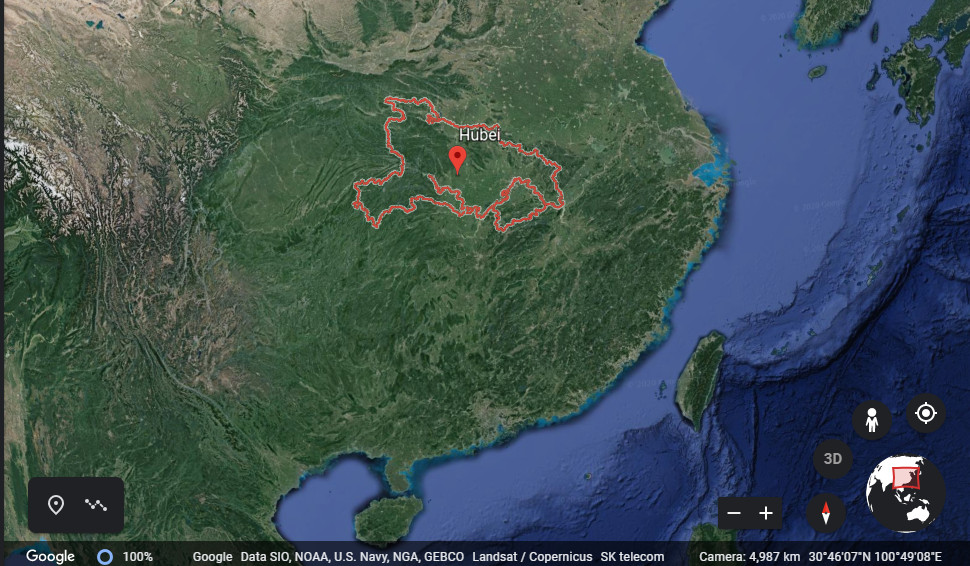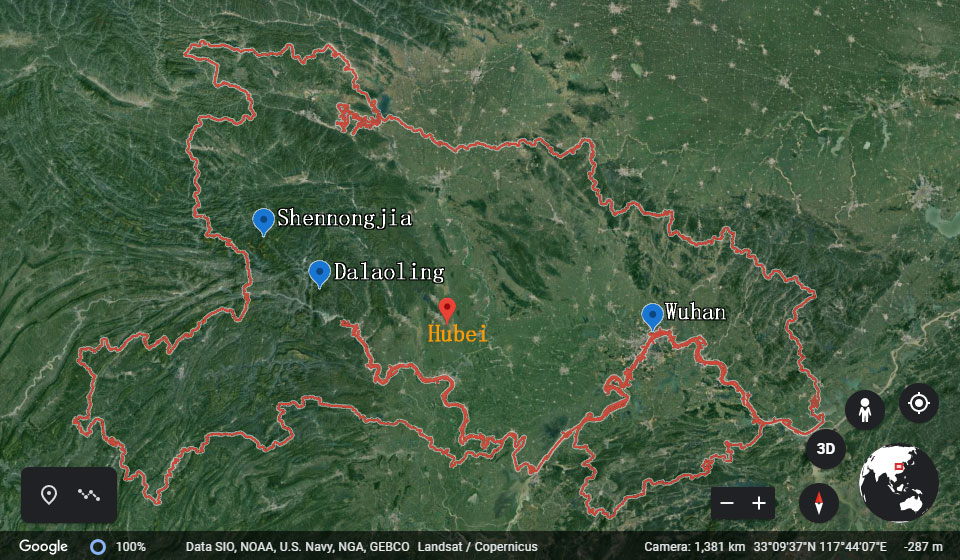Birding info of Hubei, China

Hubei is a landlocked province of China, and is part of the Central China region. The name of the province means "north of the lake", referring to its position north of Dongting Lake. The provincial capital, Wuhan, serves as a major transportation hub and the political, cultural, and economic hub of central China.
The Jianghan Plain takes up most of central and southern Hubei, while the west and the peripheries are more mountainous, with ranges such as the Wudang Mountains, the Jing Mountains, the Daba Mountains, and the Wu Mountains (in rough north-to-south order). The Dabie Mountains lie to the northeast of the Janghan Plain, on the border with Henan and Anhui; the Tongbai Mountains lie to the north on the border with Henan; to the southeast, the Mufu Mountains form the border with Jiangxi. The highest peak in Hubei is Shennong Peak, found in the Daba Mountains of the forestry area of Shennongjia; it has an altitude of 3,105 m. The two major rivers of Hubei are the Yangtze River and its left tributary, the Han River; they lend their names to the Jianghan Plain – Jiang representing the Yangtze and han representing the Han River. The Yangtze River enters Hubei from the west via the Three Gorges; the Han River enters the province from the northwest. After crossing most of the province, the two great rivers meet at the center of Wuhan, the provincial capital.Thousands of lakes dot the landscape of Hubei's Jianghan Plain, giving Hubei the name of "Province of Lakes"; the largest of these lakes are Liangzi Lake and Hong Lake.
Rich mountains and wetlands provide habitats for many rare animals and plants. Such as Golden Snub-nosed Monkey, Oriental Stork, etc. And More than 440 bird species have been recorded in Hubei.
Some Important Birding Sites in Hubei

Dalaoling National Forest Park
On the northern bank of the Ming Gorge (one of the Three Gorges on the Yangtze River), the Dalaoling National Forest Park, which is 100 kilometers from Yichang City, stands facing the Three Gorges Project in the south. With an average elevation of 1,700 meters, it has a total area of 64 square kilometers.
The natural scenery in the park is very beautiful, with peaks rising one higher than the other, a vast sea of trees, crisscrossing ravines, buhbling springs and hanging waterfalls. The park boasts wellpreserved virgin forests, and 89 percent of its total area is covered by forests. Thanks to its well preserved natural eco-environment, the park is known as a "green warehouse" and "paradise for animals. More than 150 bird species have been recorded here. Such as Golden Pheasant, Crested Honey-buzzard, Besra, Grey-capped Woodpecker, Great Spotted Woodpecker, Crimson-breasted Woodpecker, Long-tailed Minivet, Collared Crow, Yellow-bellied Tit, Black-bibbed Tit, Pygmy Cupwing, Collared Finchbill, Brown-breasted Bulbul, Chinese Leaf Warbler, Buff-throated Warbler, Chestnut-crowned Warbler, Grey-hooded Fulvetta, Grey-headed Parrotbill, Streak-breasted Scimitar-Babbler, Spotted Laughingthrush, White-throated Laughingthrush, Elliot's Laughingthrush, White-crowned Forktail, Vinaceous Rosefinch, Slaty Bunting, etc.
Shennongjia
Shennongjia Forestry District is named after the Shennongjia mountainous massif, which is usually considered to be the eastern (and the highest) section of the Daba Mountains. It lies within the Daba Mountains evergreen forests ecoregion. Some of Hubei's highest mountains - which are also the highest mountains of the Daba Shan - are located within the district. There are a number of conservation areas in the district's mountains and wetlands, in particular the world-famous Shennongjia National Nature Reserve, listed on UNESCO's World Network of Biosphere Reserves. The reserve includes 2,618 square kilometres of forest, and due to a variety of natural conditions at different elevations, has high plant diversity. One survey by Chinese botanists reports 3,479 higher plant species found in a certain area. The protected animal species include Golden Snub-nosed Monkey, whose population is over 1200. A specially protected 100-square-km area is designated for this endangered primate species. The birds you can find here include Grey-faced Buzzard, Eurasian Sparrowhawk, Eurasian Jay, Coal Tit, Rufous-vented Tit, Yellow-bellied Tit, Grey-crested Tit, Sooty Tit, Collared Finchbill, Brown-breasted Bulbul, Spotted Laughingthrush, Chinese Babax, Siberian Rubythroat, Golden Bush-Robin, Blue-fronted Redstart, Slaty Bunting, etc.
East Lake and Luoyan Scenic Area
As the most famous lake in Wuhan, East Lake covers 33 km2 neighboring the most famous university Wuhan University. There are 34 hills sitting by the side of East Lake. More than 230 bird species have been recorded here. In winter, you can see large number of birds come here for winter. The Luoyan Scenic Area, which is located in the north of East Lake, has well-protected wetlands and is the paradise for many migratory birds including Pheasant -tailed Jacana, Slaty-breasted Rail, Common Goldeneye, Yellow Bittern, Long-toed Stint, Chinese Penduline Tit, Chestnut Bunting, Chinese Bamboo Partridge, Black-naped Oriole, Eurasian Jay, Azure-winged Magpie, Yellow-bellied Tit, Collared Finchbill, Silver-throated Bushtit, Hwamei, Masked Laughingthrush, White-browed Laughingthrush, Vinous-throated Parrotbill, Dusky Thrush, Chinese Grosbeak, Yellow-throated Bunting, etc.
Wuhan Botanical Garden
With more than 8,000 plant species, Wuhan Botanical Garden covers over 70 hectares to the east of East Lake. The good vegetation provides good habitat for birds including some rare species. The birds you can find here include Chinese Bamboo Partridge, Striated Heron, Chinese Pond Heron, Crested Goshawk, Asian Koel, Large Hawk-Cuckoo, Speckled Piculet, Grey-capped Pygmy Woodpecker, Black-winged Cuckooshrike, Black-naped Oriole, Ashy Drongo, Red-billed Blue Magpie, Yellow-bellied Tit, Collared Finchbill, Mountain Bulbul, Brownish-flanked Bush Warbler, Pallas's Leaf Warbler, Masked Laughingthrush, Grey-backed Thrush, Japanese Thrush, Dusky Thrush, Blue Whistling Thrush, Chinese Grosbeak, Yellow-throated Bunting, etc.
Yujiashan Hill
Located to the north of Huazhong University for Science and Technologies, Yujiashan is the highest peak standing 149.5 above the sea level in the Wuhan area. The quiet forest on the hill is good place for birding. You have chances to see Chinese Bamboo Partridge, Common Pheasant, Scaly Thrush, Crested Honey-buzzard, Crested Goshawk, Japanese Sparrowhawk, Eurasian Sparrowhawk, Amur Falcon, Eurasian Hobby, Speckled Piculet, Grey-headed Woodpecker, Bay Woodpecker, Red-billed Blue Magpie, Yellow-bellied Tit, Light-vented Bulbul, Mountain Bulbul, Masked Laughingthrush, Blue-winged Minla, Chestnut-flanked White-eye, Red-billed Starling, Siberian Thrush, Scaly Thrush, Grey-backed Thrush, Japanese Thrush, Eyebrowed Thrush, Orange-flanked Bluetail, Dark-sided Flycatcher, Asian Brown Flycatcher, Mugimaki Flycatcher, Blue-and-white Flycatcher, Chinese Grosbeak, Tristram's Bunting, etc.
Maanshan Forest Park
Located in the east of Wuhan, Maanshan Forest Park consists of forest, ponds, farmlands and tree nurseries. More than 80% of the park is covered by trees that serve as habitats for birds. Here you have chance to see Chinese Bamboo Partridge, Crested Honey-buzzard, Japanese Sparrowhawk, Eastern Buzzard, Eurasian Hobby, Speckled Piculet, Grey-capped Pygmy Woodpecker, Bay Woodpecker, Brown Shrike, Black Drongo, Eurasian Jay, Red-billed Blue Magpie, Yellow-bellied Tit, Collared Finchbill, Mountain Bulbul, Silver-throated Bushtit, Brownish-flanked Bush Warbler, Pallas's Leaf Warbler, Plain Prinia, Masked Laughingthrush, Vinous-throated Parrotbill, Red-billed Starling, Grey-backed Thrush, Japanese Thrush, Grey-winged Blackbird, Dusky Thrush, Blue Whistling Thrush, Yellow-rumped Flycatcher, Chinese Grosbeak, Eurasian Siskin, Yellow-throated Bunting, etc.
Last one: Birding info of Henan, China
Next one: Birding info of Hunan, China







